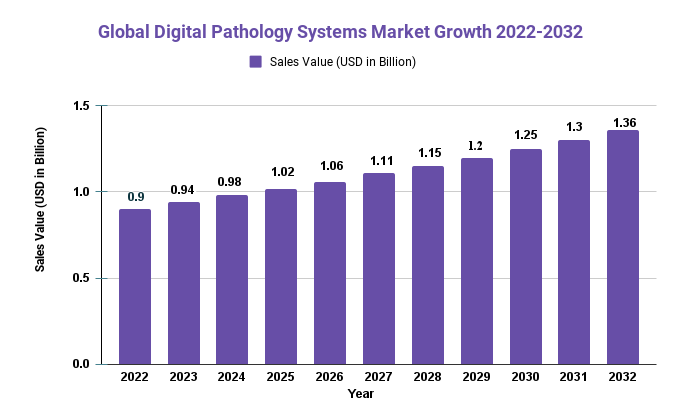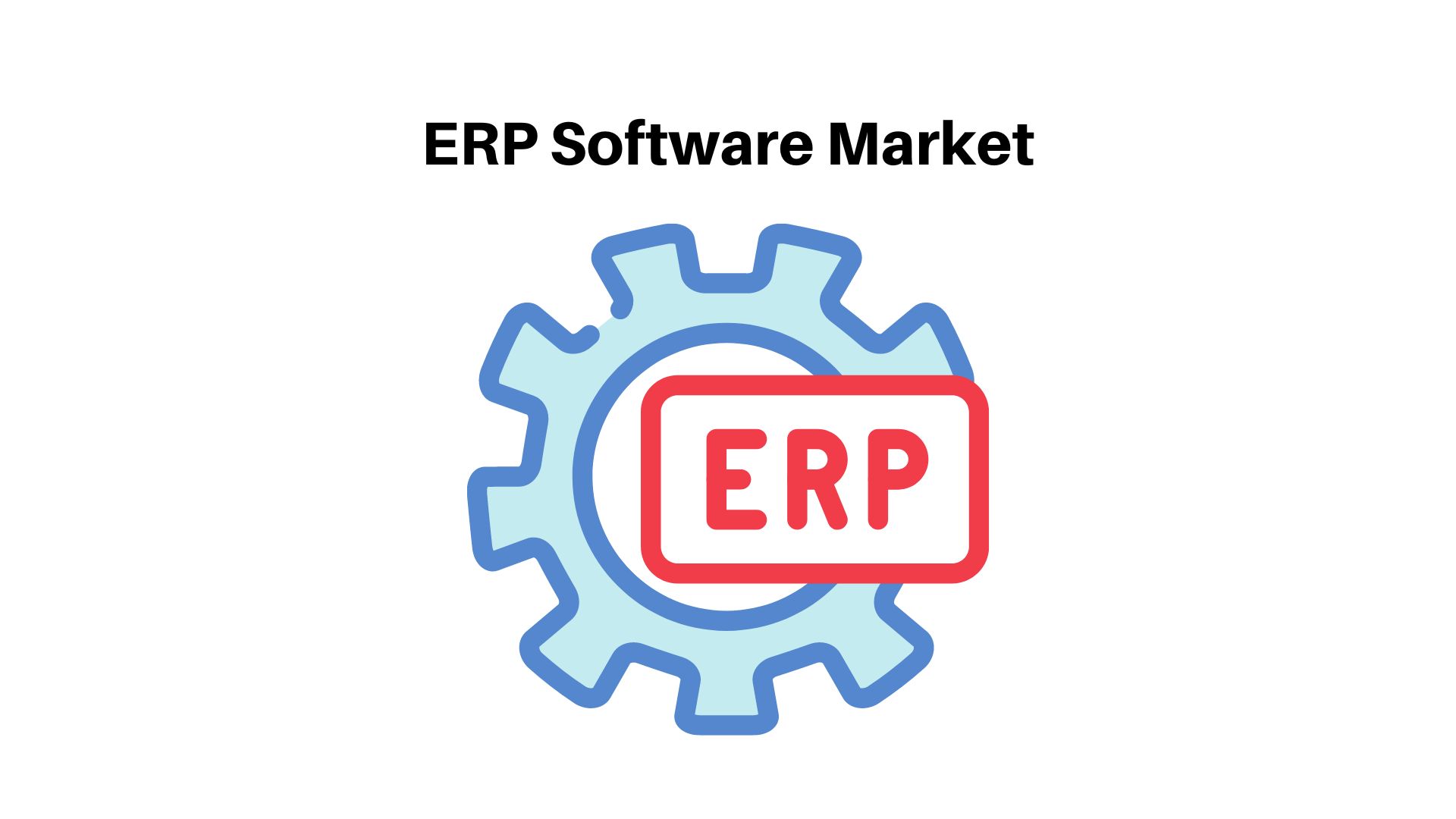Digital Pathology Systems Market is Estimated to Showcase Significant Growth of USD 1.36 Bn in 2032 With a CAGR 4.2%

Page Contents
Market Overview
Published Via 11Press: The Global Digital Pathology Systems Market was experiencing strong growth, which is expected to continue in the upcoming years. Digital pathology systems digitize and analyze pathological specimens, becoming increasingly popular due to their advantages over traditional microscopy methods.
The global digital pathology systems market was valued at USD 0.90 Bn in 2022 and is projected to reach a value of USD 1.36 Bn by 2032, growing at a compound annual growth rate (CAGR) of 4.2% during the forecast period.
One of the primary drivers of growth for digital pathology systems is an increasing prevalence of chronic diseases such as cancer that require accurate and timely diagnosis and treatment. Digital pathology systems offer faster diagnoses with higher precision, allowing clinicians to make more informed treatment decisions with confidence.
Another factor propelling growth in the digital pathology systems market is the increasing adoption of telepathology, which allows pathologists to remotely review and diagnose digital images. This proves particularly advantageous in remote or underserved areas where access to pathology services may be limited.

Drivers, trends, and challenges have an impact on market dynamics, which can impact businesses. Request for PDF sample report
Key Takeaways
- The global digital pathology systems market is expected to witness rapid growth over the coming years due to factors such as an increasing prevalence of chronic diseases and the adoption of telepathology.
- North America is currently the leading market for digital pathology systems, followed by Europe and Asia-Pacific.
- The Asia-Pacific region is forecasted to experience the highest growth in coming years, driven by the increasing adoption of digital pathology systems in emerging economies such as China and India.
- The leading players in the digital pathology systems market include Philips Healthcare, Leica Biosystems, Roche Diagnostics, Hamamatsu Photonics, and Ventana Medical Systems.
- The market is highly competitive and marked by frequent product launches and acquisitions.
Regional Snapshot
- North America is the leading market for digital pathology systems, due to the increasing adoption of this technology and the presence of major players in the region.
- Europe: A significant market for digital pathology systems has emerged due to factors such as the rising prevalence of chronic diseases and the adoption of telepathology.
- Asia-Pacific: This region is experiencing rapid growth in the market for digital pathology systems, due to the increased adoption of this technology in emerging economies such as China and India.
- Middle East & Africa: This relatively small but growing market for digital pathology systems has been spurred on by increasing investments in healthcare infrastructure as well as the adoption of advanced diagnostic technologies.
- Latin America: The market for digital pathology systems is expanding due to factors such as the increasing prevalence of chronic diseases and the adoption of telepathology.
Drivers
- Rising Incidence of Chronic Diseases: Chronic diseases such as cancer are becoming increasingly prevalent around the world, necessitating accurate diagnosis and timely treatment. Digital pathology systems enable faster diagnoses with greater precision, giving clinicians more information to make informed treatment decisions.
- Adoption of Telepathology: Telepathology is becoming more widely utilized as a way to remotely review and diagnose digital images, particularly in remote or underserved areas where access to pathology services may be limited. This has spurred demand for digital pathology systems that capture high-quality images and transmit them securely over the internet.
- Technological Advancements: The digital pathology systems market is reaping the rewards of ongoing technological developments, such as improvements to imaging quality and more sophisticated image analysis tools. These advancements allow pathologists to detect diseases at an earlier stage, leading to improved patient outcomes.
- Increased Healthcare Expenditure: As healthcare expenditures worldwide continue to rise, healthcare providers are investing in technologies that can enhance patient outcomes and cut costs. Digital pathology systems are seen as an invaluable asset in this effort since they improve diagnoses with greater accuracy and efficiency, thus eliminating the need for costly follow-up tests.
Restraints
- High Cost of Digital Pathology Systems: Digital pathology systems can be expensive to purchase and maintain, particularly for small to medium-sized laboratories. This poses a major barrier to adoption – particularly in developing countries with limited healthcare budgets.
- Data Security Concerns: The digital pathology systems market is heavily dependent on the secure transmission and storage of patient data. Any security breaches or data breaches could significantly undermine patient trust in the system, potentially hindering adoption and growth in this sector.
- Lack of Standardization: Unfortunately, there is currently a lack of standardization in the digital pathology systems market, particularly regarding image formats and data analysis tools. This can cause interoperability issues between different systems, restricting their usefulness for clinicians.
- Regulatory Obstacles: Digital pathology systems require regulatory approval in many countries, which can be a lengthy and expensive process. This delays the adoption of new technologies and limits market growth.
- Limited Awareness and Adoption: Despite the advantages of digital pathology systems, there remains a lack of awareness and adoption in some regions, particularly developing ones. This can restrict market growth potential and slow down innovation activity.
Opportunities
- Expansion into Emerging Markets: Emerging regions such as Asia-Pacific, Latin America, and the Middle East offer significant prospects for growth in the digital pathology systems market. These regions are experiencing rapid economic development and increasing investments in healthcare infrastructure – driving demand for advanced diagnostic technologies.
- Collaboration With AI and Machine Learning Companies: As artificial intelligence (AI) and machine learning (ML) technologies become more widely employed in digital pathology systems, this presents significant opportunities for innovation. Collaborating with these companies allows digital pathology system manufacturers to create more advanced image analysis tools that could enhance accuracy and efficiency during diagnosis.
- Development of Cloud-Based Platforms: Cloud-based platforms offer remote access to digital pathology images and analysis tools, making it simpler for pathologists to collaborate and share data. This presents exciting possibilities for the creation of new products and services that can improve patient outcomes while decreasing costs.
- Integration with Electronic Health Records (EHRs): Integrating digital pathology systems with EHRs can improve diagnoses' precision and efficiency, allowing clinicians to make more informed treatment decisions. This presents opportunities for manufacturers of digital pathology systems to create products that seamlessly integrate with existing EHR infrastructures.
Challenges
- The complexity of Implementation: Adopting digital pathology systems can be complex and require significant adjustments to current laboratory workflows, creating a significant obstacle to adoption – particularly for smaller laboratories with limited resources.
- Limited Interoperability: There is a lack of standardization in the digital pathology systems market, which could cause interoperability issues between different systems. This limits the usefulness of digital pathology systems for clinicians and slows down innovation within this sector.
- Regulatory Obstacles: Digital pathology systems require regulatory approval in many countries, which can be a lengthy and expensive process. This delays the adoption of new technologies and restricts market expansion.
- Data Security Concerns: The digital pathology systems market is heavily dependent on the secure transmission and storage of patient data. Any security breaches or data breaches could erode patient trust in the system, potentially restricting adoption and growth within this market.
- High Implementation Cost: Digital pathology systems can be expensive to buy and maintain, particularly for small to medium-sized laboratories. This poses a significant barrier to adoption in developing countries with limited healthcare budgets.
Recent Developments
- On February 2022, Leica Biosystems launched the Aperio LV1 digital pathology system which provides high-resolution imaging of large whole-slide specimens, making complex tissue analysis simpler.
- On December 2021, Philips unveiled their IntelliSite Pathology Solution 9.0 with an improved user interface and advanced AI tools for image analysis.
- On November 2021, Roche announced their acquisition of PathAI, a leader in AI-powered pathology solutions. This acquisition is expected to further solidify Roche's position within the digital pathology market.
- On October 2021, Hamamatsu Photonics unveiled the NanoZoomer S360, a digital pathology system that offers rapid scanning and analysis of whole slide specimens.
- On August 2021, Proscia unveiled their DermAI platform – an AI-driven digital pathology system capable of accurately diagnosing skin cancer.
Key Market Segments
Type
- Slide Scanners
- Analytics
- Delivery Modes
- Virtual Microscopy
- Static Telepathology
- Dynamic Telepathology
Application
- Drug Discovery and Development
- Disease Diagnosis
- Academic Research
Key Market Players
- Definiens
- Digipath
- Ventana
- Nikon
- Visiopharm
- Philips Healthcare
- Indica Labs
- Omnyx
- 3DHISTECH
- Leica Microsystems
Report Scope
| Report Attribute | Details |
| The market size value in 2022 | USD 0.90 Bn |
| Revenue forecast by 2032 | USD 1.36 Bn |
| Growth Rate | CAGR Of 4.2% |
| Regions Covered | North America, Europe, Asia Pacific, Latin America, and Middle East & Africa, and Rest of the World |
| Historical Years | 2017-2022 |
| Base Year | 2022 |
| Estimated Year | 2023 |
| Short-Term Projection Year | 2028 |
| Long-Term Projected Year | 2032 |
Frequently Asked Question
Q: What is digital pathology?
A: Digital pathology is the use of digital imaging technology to capture, store and analyze pathology images.
Q: What are the advantages of digital pathology systems?
A: Digital pathology systems can enhance diagnoses with greater accuracy and efficiency, facilitate remote collaboration and consultation, and reduce costs associated with traditional pathology workflows.
Q: What are some common applications of digital pathology?
A: Digital pathology has numerous applications, such as cancer diagnosis and research, drug development, infectious disease diagnosis, and more.
Q: What are some of the challenges associated with implementing digital pathology systems?
A: Some of the difficulties may include the complexity of implementation, limited interoperability, high costs, regulatory hurdles, and data security concerns.
Q: What is the future of the digital pathology market?
A: The digital pathology market is expected to experience strong growth over the coming years due to factors such as increasing demand for advanced diagnostic technologies, expansion of healthcare infrastructure in emerging markets, and growing adoption of AI/machine learning techniques in pathology practice.
The team behind market.us, marketresearch.biz, market.biz and more. Our purpose is to keep our customers ahead of the game with regard to the markets. They may fluctuate up or down, but we will help you to stay ahead of the curve in these market fluctuations. Our consistent growth and ability to deliver in-depth analyses and market insight has engaged genuine market players. They have faith in us to offer the data and information they require to make balanced and decisive marketing decisions.



